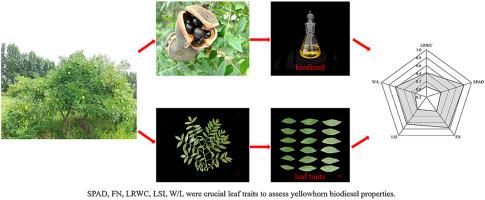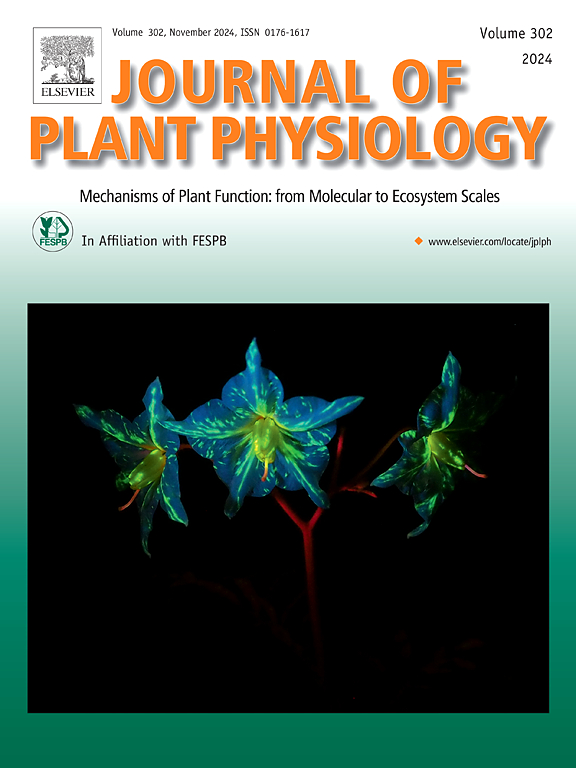通过表型标记开发优化黄角木本油生物柴油生产:性状指数关联和种质筛选研究
IF 4.1
3区 生物学
Q1 PLANT SCIENCES
引用次数: 0
摘要
黄角果(Xanthoceras sorbifolia Bunge)的种子油是一种很有前途的生物柴油生产原料,但与其质量相关的检测过程既繁琐又昂贵。这项工作的重点是早期选择优质种质,以降低生产成本和提高遗传收益。通过对通辽市试验示范基地黄角25个叶片数量性状与8个生物柴油表征指标的关系分析,发现叶片土壤植物分析发育(SPAD)、叶数(FN)、叶含水量(LRWC)、叶形指数(LSI)和蜡叶厚比(W/L) 5个关键叶片功能性状与生物柴油表征指标具有显著相关性。这些性状是预测生物柴油质量的重要指标。此外,还建立了一个预测图谱来描绘生物柴油的最佳特性,包括SPAD(35.00-49.92)、FN(13.17-18.83)、LRWC(0.37% - 0.51%)、LSI(0.23-0.40)和W/L(0.01-0.04)。本研究结果为利用直观、可测试的性状预测复杂指标提供了技术支持,从而为优质生物柴油黄角种质育种的初步选择提供了便利。本文章由计算机程序翻译,如有差异,请以英文原文为准。

Optimizing woody oil biodiesel production in yellowhorn via phenotypic marker development: a study of trait–index associations and germplasm screening
The seed oil of yellowhorn (Xanthoceras sorbifolia Bunge) represents a promising feedstock for biodiesel production, but the detection process associated with its quality is both cumbersome and costly. This work focused on early selection of high-quality germplasm to reduce production costs and enhance genetic gains. An analysis of the relationships between 25 quantitative leaf traits and 8 biodiesel characterization indices in yellowhorn at the experimental and demonstration base in Tongliao City, China, identified 5 key leaf functional traits—leaf Soil Plant Analysis Development (SPAD), frond number (FN), leaf rate of water content (LRWC), leaf shape index (LSI), and the wax-to-leaf thickness ratio (W/L)—that showed significant correlations with the biodiesel characterization indices. These traits were identified as critical indicators for predicting biodiesel quality. Furthermore, a predictive map was developed to delineate optimal biodiesel characteristics, encompassing the ranges of SPAD (35.00–49.92), FN (13.17–18.83), LRWC (0.37 %–0.51 %), LSI (0.23–0.40), and W/L (0.01–0.04). The findings of this study provide technical support for employing straightforward and testability traits to forecast complex indicators, thereby facilitating the preliminary selection of high-quality biodiesel yellowhorn germplasm breeding.
求助全文
通过发布文献求助,成功后即可免费获取论文全文。
去求助
来源期刊

Journal of plant physiology
生物-植物科学
CiteScore
7.20
自引率
4.70%
发文量
196
审稿时长
32 days
期刊介绍:
The Journal of Plant Physiology is a broad-spectrum journal that welcomes high-quality submissions in all major areas of plant physiology, including plant biochemistry, functional biotechnology, computational and synthetic plant biology, growth and development, photosynthesis and respiration, transport and translocation, plant-microbe interactions, biotic and abiotic stress. Studies are welcome at all levels of integration ranging from molecules and cells to organisms and their environments and are expected to use state-of-the-art methodologies. Pure gene expression studies are not within the focus of our journal. To be considered for publication, papers must significantly contribute to the mechanistic understanding of physiological processes, and not be merely descriptive, or confirmatory of previous results. We encourage the submission of papers that explore the physiology of non-model as well as accepted model species and those that bridge basic and applied research. For instance, studies on agricultural plants that show new physiological mechanisms to improve agricultural efficiency are welcome. Studies performed under uncontrolled situations (e.g. field conditions) not providing mechanistic insight will not be considered for publication.
The Journal of Plant Physiology publishes several types of articles: Original Research Articles, Reviews, Perspectives Articles, and Short Communications. Reviews and Perspectives will be solicited by the Editors; unsolicited reviews are also welcome but only from authors with a strong track record in the field of the review. Original research papers comprise the majority of published contributions.
 求助内容:
求助内容: 应助结果提醒方式:
应助结果提醒方式:


